Cognitive behavioral therapy (CBT) and Transactional analysis (TA) have a number of commonalities. One obvious example being the similarity of what CBT calls automatic thoughts to the TA idea of early decisions. Automatic thoughts are faulty beliefs one develops in childhood, which result in problem behaviour and feelings later in adulthood. The faulty beliefs become ingrained patterns of thinking such that the person is often unaware they are influenced by them.
A recent significant contribution to the literature on CBT therapy and theory is presented by:
Judith S. Beck
2011. Cognitive Behaviour Therapy: Basics and Beyond. Second Edition. The Guilford Press: New York.
In this book she presents the idea of what is called a “hierarchy of cognition” (P36). This provides a hierarchical structure to core beliefs and automatic thoughts shown below, (P35)
The nature of core beliefs is described by Beck (2011) in the following:
“Core beliefs are the most fundamental level of belief; they are global, rigid, and overgeneralized. Automatic thoughts, the actual words or images that go through a person’s mind, are situation specific and may be considered the most superficial level of cognition. The following section describes the class of intermediate beliefs that exists between the two”. (P34)
“How do core beliefs and intermediate beliefs arise? People try to make sense of their environment from their early developmental stages. They need to organize their experience in a coherent way in order to function adaptively (Rosen, 1988). Their interactions with the world and other people, influenced by their genetic predisposition, lead to certain understandings: their beliefs, which may vary in their accuracy and functionality. Of particular significance to the cognitive behavior therapist is that dysfunctional beliefs can be unlearned, and more reality-based and functional new beliefs can be developed and strengthened through treatment”. (P35)
“People develop these beliefs from an early age, as children, with their genetic predisposition toward certain personality traits, interact with significant others, and encounter a series of situations”. (P228)
Put a child under significant stress and its natural temperament will begin to show. Is this flight, fight or freeze?
This sounds very similar to what the Goulding's presented in 1976 with their theory of early decisions. (Goulding & Goulding 1976. Injunctions, Decisions, and Redecisions. Transactional Analysis Journal, 6(1), 41 - 48.) As children develop they are from time to time confronted with distressing situations. When these happen the child will feel a need to make sense of them and this results in making early decisions which result in the injunctions which are automatic ways of thinking about self, others and the world. They proposed eleven injunctions in all:
Don’t exist
Don’t be you (sex you are)
Don’t be a child
Don’t grow up
Don’t make it (succeed)
Don’t
Don’t be close
Don’t belong
Don’t be well (sane)
Don’t think
Don’t feel
This in essence, is a list of automatic thoughts which the Goulding's observed occurred repetitively.
Hierarchy of cognition
What Beck (2011) provides is a hierarchical structure to core beliefs and automatic thoughts as was described above. This can be adapted to Transactional Analysis theory leading to a hierarchy of inborn temperament, life positions (core beliefs) and early decisions (Automatic thoughts).
A similar model could be presented here
To explain further, examples of this are provided here in relation to the suicide decision. The suicide decision is included in what the Goulding's called the Don’t exist injunction. This one injunction actually includes a subset of seven different types of suicide decisions as shown here
If you don’t change I will kill myself
If things get too bad I will kill myself
I will show you even if it kills me
I will get you to kill me
I will kill myself by accident
I will almost die (over and over) to get you to love me
I will kill myself to hurt you
When confronted with distressing circumstances some children will make a suicide decision similar to one of the above. The two examples presented below show how this can occur in a hierarchical structure.
We all have a natural temperament of some kind whether that be flight, fright or freeze. Then at a young age, probably preverbal we develop a basic belief (Core belief) about ourselves and others which in transactional analysis terms can be seen as the life positions. Sometimes this can also include an injunction that is especially influential. These in the past have been called core injunctions and the other injunctions are seen to be especially influenced by these. A good example of this can be the Don’t trust injunction which can become one of the core components of the personality.
After the core belief has been established the young child then makes a series of early decisions in times of particular distress and these are influenced by their temperament and the core beliefs. The two examples above show how the temperament in particular can influence the decisions made and then the final behavioral outcome.
In a similar way this hierarchical model can be used to demonstrate the development of physically violent behaviour as is shown below.
When people make the suicide decision they decide that suicide is an option for them in times of high stress. The same applies for people who use physical violence as is found in domestic violence. The young child decides that to physically hit others is an option in times of high stress. If one has not made this decision then they will rarely use physical violence.
Graffiti
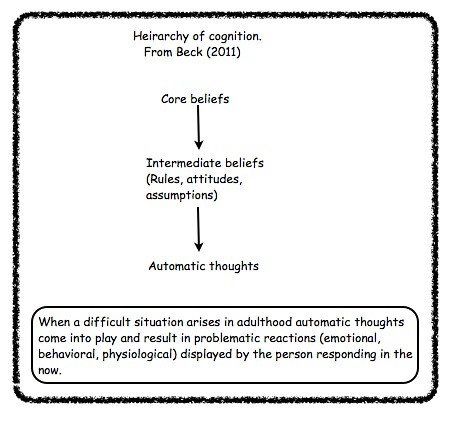
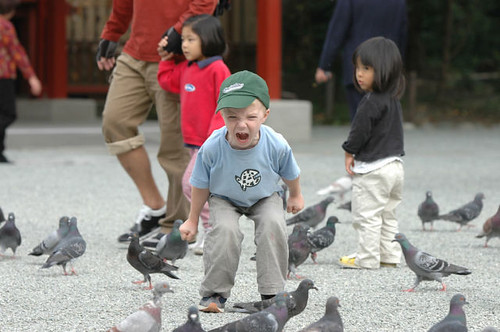
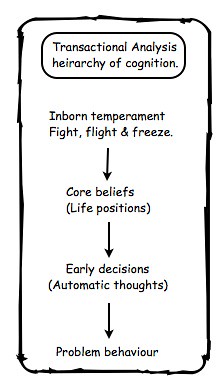
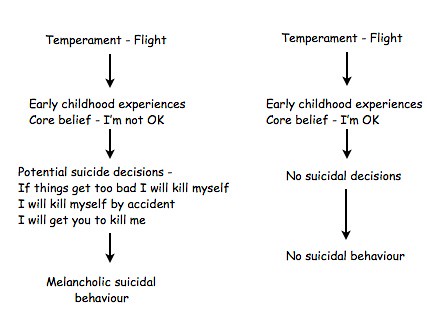
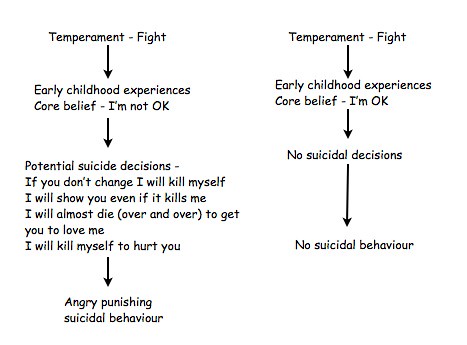
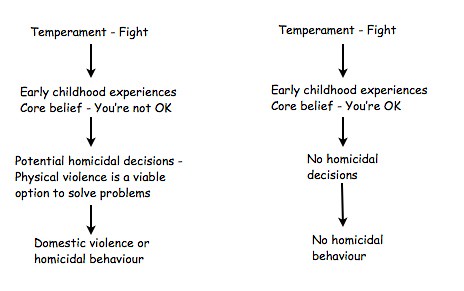
No comments:
Post a Comment